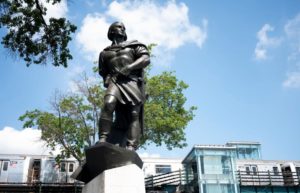Correction & clarification: An earlier version of this story misrepresented a percentage. The U.S. National Human Trafficking Hotline saw a nearly 20% increase in the number of victims and survivors directly contacting the hotline from 2018 to 2019.
British socialite Ghislaine Maxwell was found guilty this month of luring teenage girls to be sexually abused by American financier Jeffrey Epstein. Her trial brought the stories of human trafficking survivors into the public eye, but much more often, trafficking operates in the shadows.
January is National Slavery and Human Trafficking Prevention Month, which includes Tuesday’s National Human Trafficking Awareness Day – set apart to raise awareness and funds for victims. It’s a global issue: The Department of State estimates that as many as 24.9 million adults and children are trapped in some form of human trafficking around the world, including in the United States.
The U.S. National Human Trafficking Hotline saw a nearly 20% increase in the number of victims and survivors directly contacting the hotline from 2018 to 2019, according to Polaris, the nonprofit that runs the hotline for victims and survivors.
Human trafficking is prevalent, but frequently misunderstood. It changes with the times and often happens closer to home than some might believe.
“Trafficking is profoundly adaptable and dynamic,” said Caren Benjamin, chief communications officer for Polaris.
What is human trafficking?
There are two main forms of human trafficking: sex trafficking and labor trafficking.
As defined by U.S. law, sex trafficking is the recruitment, harboring, transportation, provision, obtaining, patronizing, or soliciting of a person for a commercial sex act that’s induced by force, fraud, coercion, or if the person is under 18.
Labor trafficking follows the same definition, except its purpose is subjection to involuntary servitude, peonage, debt bondage, or slavery.
A 2019 FBI study found that 80% of human trafficking cases from 2015 to 2017 involved sex-trafficking victims. Nineteen percent were victims of labor trafficking, and 1% involved both forms.
There’s no way to truly know how much human trafficking exists in the U.S. or around the world, Benjamin said. Data from the U.S. national hotline, for example, represents only victims who know enough or who aren’t scared to report trafficking.
Many people mistakenly believe someone has to be moved from one place to another to be considered a victim of human trafficking. Human trafficking, however, does not require transportation to be considered a crime, according to the Department of Homeland Security.
Why January for trafficking awareness?
The U.S. Department of State began monitoring human trafficking in 1994 after the fall of the former Soviet Union and the resulting migration flows, which led to increasing global concern about transnational criminal organizations and their use of trafficking, according to the State Department’s 2020 Trafficking in Persons Report.
In 2000, Congress passed the Victims of Trafficking and Violence Protection Act aimed at combatting human trafficking, especially involving the sex trade, slavery, and involuntary servitude.
Ten years later, President Barack Obama proclaimed January as National Slavery and Human Trafficking Prevention Month. According to the State Department, January was chosen because it was the same month Abraham Lincoln issued the Emancipation Proclamation, freeing 4 million slaves on Jan. 1, 1863.
How has COVID-19 impacted trafficking?
COVID-19 has shown that human trafficking is “pandemic-proof,” Benjamin said.
Online recruitment for sex trafficking in the U.S. has seen a steep increase during the pandemic, said Roger Martin, CEO of nonprofit Humans Against Trafficking.
“The potential victims, mostly teens, are just spending way more time unsupervised on their devices,” he said. “They tend to get more approaches by predators online, and that’s been on the rise since the beginning of COVID.”
Other factors caused by the pandemic, such as economic instability, further increase someone’s vulnerability to trafficking, Benjamin said.
“It’s important to always remember that human trafficking doesn’t happen in a vacuum,” she said. “The things that make people vulnerable to trafficking certainly did increase in the COVID era. There were a lot of people who were hurting economically.”
U.S. marshals, who often conduct operations to recover missing, endangered, or abducted children, assisted with the recovery of 950 “critically missing children” in 2021, an approximately 145% increase over 2020.
One of every 6 children recovered has likely been a victim of human trafficking, said Dave Oney, a public affairs specialist with the Marshals.
Labor-trafficking demand is driven by factors such as location and season, Martin said. The primary victims of labor trafficking tend to be people who are new to a country, don’t speak its language, or might not have the skills or education to get traditional or white-collar jobs.
The 2019 FBI study found that 43% of victims recruited for labor trafficking were foreign nationals residing outside the U.S.
“They end up falling into work where it’s usually a scam,” Martin said. “They feel like they don’t have any choice – they’re kept in this perpetual cycle of getting paid less than minimum wage and working long hours. Labor traffickers will often take their ID or immigration papers, so the person can’t move around and travel.”
What are the signs of sex and labor trafficking?
Anyone can be a victim of human trafficking.
According to the White House, the people most vulnerable to human trafficking in the U.S. include youth in the welfare or juvenile justice system, runaway and homeless youth, undocumented immigrants, people of color, LGBTQ+, people with disabilities, and people with substance use disorder.
The vast majority of human trafficking is perpetrated by someone known to the victim, Benjamin said: “It is very rare that people are kidnapped by strangers and forced into trafficking situations via force and violence.”
Understanding what trafficking looks like is important, but it’s difficult to determine whether a stranger is being trafficked without jumping to conclusions. The people you are in a position to help are often people who you know, she said.
Here are common warning signs of human trafficking, according to experts:
- Unexplained absences, skipping school or work, or isolation from friends and family
- Expensive gifts that would normally be out of budget, like designer handbags or clothes
- Spending a lot of time with an older person who didn’t previously have a relationship with the potential victim
- Carrying a second phone
- Avoiding eye contact, social interaction, and authority figures or law enforcement
- Seeming to adhere to scripted or rehearsed responses in social interaction
- Lacking official identification documents
If you are a victim of human trafficking and need help, or believe you know someone who is being trafficked, you can contact the National Human Trafficking Hotline at (888) 373-7888.
This article originally appeared on USA TODAY: National Slavery and Human Trafficking Prevention Month: What to know




